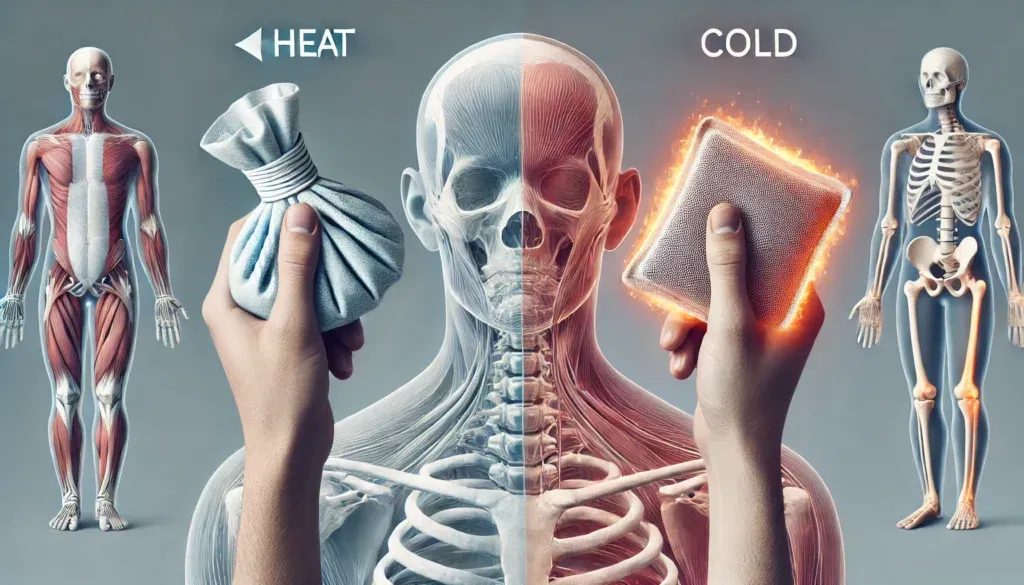Understanding Tendonitis and Its Impact
Understanding tendon pain and the appropriate treatments for it is essential for both acute injury recovery and long-term musculoskeletal health. Tendonitis, a condition characterized by inflammation or irritation of a tendon—the thick, fibrous cords that attach muscle to bone—can occur in various parts of the body. Commonly affected areas include the shoulders, elbows, wrists, knees, and heels. Despite its prevalence, there remains considerable debate about the best methods for managing this painful condition. One question that often arises is whether heat or cold therapy is more effective for relieving symptoms. By diving deeply into current medical literature, exploring biological responses to temperature, and integrating real-world applications, this article provides evidence-based guidance for determining the best modality—ice or heat—for treating tendonitis.
You may also like: How Does Cryotherapy Work? Exploring the Science, Benefits, and What to Expect After Treatment
Causes and Symptoms of Tendonitis
Tendonitis can affect anyone, but it is especially common among athletes, manual laborers, and aging populations. Repetitive movements, overuse, and improper biomechanics are frequent culprits. When tendons become inflamed, the affected joint may feel painful, stiff, and swollen. Depending on the severity, these symptoms can be short-term or persist for months if not properly managed. Thus, selecting an effective treatment method early in the healing process can significantly improve outcomes and reduce the risk of chronic pain.
Heat or Cold? Understanding the Basics
Many people ask, “Should I use tendon pain ice or heat?” or search for phrases like “what is best for tendonitis heat or cold?” These questions are more than semantics—they reflect a critical therapeutic decision. Each treatment—ice and heat—serves a distinct physiological purpose. Cold therapy, or cryotherapy, is primarily used to reduce inflammation, numb sharp pain, and decrease tissue metabolism. It is especially effective immediately after injury, when swelling is most prominent. Conversely, heat therapy, also known as thermotherapy, helps increase blood flow, relax muscles, and improve tissue elasticity. It is generally more appropriate in the subacute or chronic phase of healing.
Biological Mechanisms and Inflammation
Understanding how heat or cold tendonitis treatment affects the body starts with an appreciation of the inflammatory process. When a tendon is overused or injured, inflammation begins as the body’s natural defense mechanism. Increased blood flow to the area brings immune cells and nutrients to promote healing. However, prolonged inflammation can lead to tissue damage and chronic pain. This is why using ice or heat for tendonitis at the correct time is so important. Ice is ideal during the acute phase to reduce blood flow and prevent further swelling, while heat is more beneficial later to encourage flexibility and circulation.
Timing Is Key: Acute vs. Chronic Stages
In the early stages—typically within 48 to 72 hours of the injury—cold therapy is often the preferred option. During this phase, signs such as redness, warmth, swelling, and intense pain are common. Applying an ice pack or cold compress for 15–20 minutes several times a day helps reduce these symptoms. Scientific studies confirm that cold application helps decrease nerve activity, reduce muscle spasms, and minimize metabolic demand on injured tissues. These effects make cold therapy a mainstay in the early treatment of tendonitis.
Heat for Stiffness and Recovery
Once the acute inflammation has diminished, the focus shifts to restoring function and mobility. At this point, heat therapy can play a pivotal role. Applying a heating pad or warm towel enhances vasodilation, increasing the delivery of oxygen and nutrients to the injured tissue. This supports tissue regeneration and alleviates stiffness. For individuals suffering from lingering or recurring tendon discomfort, heat therapy can be especially beneficial. The question of whether to use heat or ice for tendonitis hinges heavily on this phase-specific approach, and those who apply therapy accordingly often report better outcomes.

When Can Heat Help a Pulled Muscle?
An often-asked question is, “Can heat help a pulled muscle or tendon?” The answer lies in understanding the healing timeline. While heat can exacerbate inflammation if used too early, it becomes an invaluable ally in the later stages of healing or when dealing with chronic tendon issues. For example, someone with persistent patellar tendonitis may find morning stiffness relieved through warm compresses. In this context, a tendonitis hot or cold compress approach—utilizing both modalities at different times—is often the most effective solution.
Individualized Treatment Considerations
It’s important to tailor treatment based on individual factors. People with conditions such as diabetes, Raynaud’s phenomenon, or peripheral neuropathy must be especially cautious. These individuals may have impaired sensation or circulation, which increases the risk of injury from extreme temperatures. A one-size-fits-all recommendation does not work for ice or heat tendinitis therapy. Clinical professionals often suggest short, closely monitored applications, using barriers like towels between the skin and the heat or cold source.
Temperature Therapy in Holistic Rehab
Integrating temperature therapy into a broader rehabilitation plan amplifies its benefits. Physical therapy exercises, ergonomic modifications, and anti-inflammatory medications can complement the effects of heat or cold. For example, athletes recovering from rotator cuff tendonitis may use heat before physical therapy to loosen tissues and ice afterward to manage soreness. This approach to cold or hot for tendonitis emphasizes strategic timing, showing how multiple tools can work in concert.
Clarifying Misconceptions and Public Awareness
The ongoing popularity of the question “Is heat or cold better for tendonitis?” suggests a need for better public education. The answer isn’t universal—it depends on timing, symptomatology, and personal health history. Pain that presents with swelling usually benefits more from cold therapy. In contrast, dull, aching pain and stiffness that persist after inflammation has subsided are more responsive to heat. The right treatment choice should always be guided by how the tendon is currently responding.
Contrast Therapy: Combining Modalities
Contrast therapy, which alternates heat and cold, is another promising method. This technique can stimulate circulation and promote healing by causing blood vessels to alternately constrict and dilate. A typical cycle might involve three minutes of heat followed by one minute of cold, repeated for 20 minutes. While high-quality studies are limited, contrast therapy is commonly used by physical therapists for chronic cases, especially in sports medicine. Anecdotal evidence suggests it can help alleviate pain and reduce inflammation simultaneously.
The Role of Evidence vs. Personal Preference
It’s also important to address the misconception that personal comfort should guide treatment decisions. Although people may prefer one modality over the other, this shouldn’t replace evidence-based practices. Someone might find warmth soothing and apply it to a fresh injury, unknowingly increasing swelling. Conversely, relying on ice alone in chronic cases may delay recovery by reducing tissue flexibility. The science behind ice or heat for tendonitis supports a dynamic, phase-aware approach that adapts with the healing process.
Innovative Tools for Heat and Cold Therapy
Innovative technologies are changing the landscape of tendonitis care. Infrared heating pads, cryo-compression devices, and smart wearables offer controlled and sustained temperature therapy. These devices can target specific muscle-tendon junctions and maintain safe temperature levels. Some are programmable to alternate between hot and cold automatically, making them ideal for managing tendonitis in athletes and professionals who require consistent recovery strategies. As biohacking gains traction, these advanced tools exemplify how human optimization intersects with evidence-based medicine.
Psychological and Emotional Benefits
Equally vital is the mental component of healing. Chronic pain can erode emotional well-being, contributing to anxiety and depression. Incorporating heat or cold into daily self-care rituals can provide psychological relief and a sense of control. The act of managing one’s condition, even through something as simple as a warm compress, empowers patients. For this reason, clinicians often recommend these therapies not just for physical healing but for emotional support as well.
Adapting to the Body’s Signals
Educational outreach should also emphasize the importance of listening to one’s body. While guidelines exist, no protocol can fully replace individual observation. If a therapy consistently worsens symptoms, it may be time to reevaluate. Some patients respond best to a mixed approach, using a tendonitis hot or cold compress at different times of day. Others may benefit from alternating days or focusing on one therapy based on physical activity levels. Tailoring treatment is essential for long-term success.

Frequently Asked Questions: Heat or Cold for Tendonitis
1. Can alternating heat and cold therapy improve recovery outcomes for chronic tendonitis? Yes, alternating heat and cold therapy—known as contrast therapy—can be highly beneficial for chronic tendonitis. While the main article discussed contrast briefly, it’s worth expanding on its mechanisms. This technique promotes improved circulation by causing vasodilation and vasoconstriction, which helps move metabolic waste out of tissues and introduces fresh nutrients into the affected area. When applied correctly, contrast therapy may reduce lingering stiffness while minimizing the risk of excessive inflammation. People often wonder whether tendon pain needs ice or heat, but this approach provides a middle ground, especially in conditions with both pain and stiffness. It’s an advanced tool when navigating cold or hot for tendonitis care.
2. Is there any benefit in using temperature therapy before or after physical activity? Absolutely, and this is where timing becomes crucial. Using heat therapy before physical activity can help prepare tendons by increasing elasticity and blood flow. This is particularly useful when stiffness is a major complaint. On the flip side, applying cold therapy after strenuous activity helps reduce inflammation and prevent swelling, especially in cases of overuse. Athletes managing chronic conditions often ask whether they should use tendon pain ice or heat before workouts, and a dual approach—heat before, cold after—is often the most effective protocol.
3. Are there any innovative technologies that enhance heat or cold application for tendonitis? Yes, several new technologies are reshaping how we approach tendonitis treatment. Infrared heating devices offer deeper tissue penetration compared to traditional heating pads, improving blood flow in stubborn cases. Cryotherapy chambers and portable cold compression wraps can deliver targeted cold therapy more efficiently than ice packs. For those asking, “Is heat or cold better for tendonitis with high activity levels?”, these advanced tools provide a reliable solution. Devices that combine tendonitis hot or cold compress features with smart monitoring can personalize therapy and enhance safety.
4. How do psychological factors affect the choice between heat or cold for tendonitis? Mental health plays a subtle yet influential role in recovery. Chronic pain can lead to stress and anxiety, which may influence how patients perceive relief. Some find cold therapy too jarring or uncomfortable, while others feel more relaxed with heat. This perception often leads individuals to ask, “What is best for tendonitis—heat or cold from a comfort standpoint?” While scientific reasoning should guide the primary decision, recognizing a patient’s emotional response can improve adherence to treatment and overall satisfaction with recovery.
5. Can heat help a pulled muscle in combination with tendonitis? When tendonitis occurs alongside a pulled muscle, heat can indeed be a strategic ally. In such scenarios, increased blood flow supports both muscle relaxation and tendon healing. However, it’s critical to ensure that acute inflammation has subsided before introducing heat. Patients often ask, “Can heat help a pulled muscle if tendon pain persists?” The answer is yes—but only after the swelling is under control. This dual benefit highlights the complex nature of managing heat or cold tendonitis scenarios involving multiple tissues.
6. What precautions should older adults take when using hot or cold therapy for tendonitis? Older adults should be cautious due to decreased skin sensitivity and circulation, which can raise the risk of burns or frostbite. It’s essential to use a barrier—like a towel—between the skin and any hot or cold source. They should also limit application time to 15–20 minutes and inspect the skin afterward. Since age-related tendon degeneration is common, questions about tendon pain ice or heat are especially relevant to this demographic. Tailoring treatment frequency and intensity becomes critical in addressing cold or hot for tendonitis in aging joints.
7. How do environmental factors influence the effectiveness of heat or cold therapy? Environmental conditions such as ambient temperature and humidity can influence how the body responds to therapy. For instance, cold therapy may be less effective in already cold environments due to increased muscle rigidity. Similarly, hot climates can make heat therapy uncomfortable or even risky. Those who live in extreme conditions often ask, “Is heat or cold better for tendonitis when outdoor temperatures fluctuate?” Adjusting therapy according to seasonal or local factors adds nuance to tendonitis hot or cold compress routines.
8. Does diet or hydration affect how well tendonitis responds to heat or cold treatment? Yes, both hydration and nutrition play a pivotal role in soft tissue health. Well-hydrated tendons respond more flexibly to heat therapy, while cold therapy may be more effective when inflammation is well-managed through anti-inflammatory diets rich in omega-3s. Individuals who frequently ask about tendon pain ice or heat should consider their broader lifestyle habits. Consistency in hydration and nutrient intake can enhance recovery and amplify the benefits of heat or ice for tendonitis.
9. Can misuse of heat or cold therapy worsen tendonitis symptoms? Unfortunately, yes. Using heat during an active flare-up can increase inflammation and delay healing, while excessive cold application can reduce circulation too much, slowing recovery. Patients often wonder what is best for tendonitis—heat or cold—without considering timing or duration. Misapplication, such as falling asleep with a heating pad, can also lead to burns or skin irritation. Educating patients on safe practices is key to effective tendonitis hot or cold compress use.
10. What are some emerging trends in professional tendonitis treatment that incorporate temperature therapy? Emerging therapies are increasingly integrating regenerative techniques like platelet-rich plasma (PRP) with adjunctive temperature therapy. Clinics are also combining manual therapy with smart thermotherapy devices that adjust temperature in real time. For those navigating ice or heat tendinitis treatment, these innovations provide more targeted and responsive care. The future may also involve AI-driven apps that guide users through safe and effective tendonitis hot or cold compress routines. These developments represent a fusion of technology, personalization, and biohacking for optimal tendon health.

Conclusion: Making the Right Choice for Your Tendonitis Treatment
Ultimately, the debate surrounding tendon pain ice or heat is not about choosing one over the other universally. Rather, it’s about using each tool with precision, guided by biological principles and symptom evolution. Whether you’re dealing with acute inflammation or chronic stiffness, there is a role for both heat and cold. Asking “Is heat or cold better for tendonitis?” should lead to deeper questions: Where is my body in the healing process? What are my current symptoms? What activities aggravate or relieve my condition?
Answering these questions not only directs the appropriate choice of therapy but also fosters a proactive mindset toward recovery. Ice and heat are not merely symptomatic treatments; they are modalities that, when used wisely, support the natural progression of healing. From acute injury through full recovery, understanding how to alternate or combine therapies can shorten downtime, reduce pain, and improve overall tendon health.
In conclusion, determining whether to use heat or cold for tendonitis is less about blanket rules and more about context. Acute injuries respond best to cold therapy, which controls inflammation and numbs pain. Chronic conditions, characterized by stiffness and reduced mobility, often benefit more from heat, which enhances circulation and flexibility. In many cases, the combination of both—applied at the right times—delivers the most comprehensive relief. By integrating these strategies with clinical insight, technological tools, and patient education, individuals can make informed decisions that accelerate recovery and support long-term tendon health. Whether using tendonitis hot or cold compress strategies, what matters most is understanding the body’s needs and responding with care, consistency, and knowledge.
joint pain relief methods, muscle recovery techniques, inflammation management, chronic pain therapy, natural pain relief strategies, soft tissue injury care, rehabilitation best practices, physical therapy tools, biohacking recovery, pain management innovation, sports injury treatments, overuse injury prevention, cold therapy benefits, heat therapy benefits, muscle stiffness remedies, tendon injury care, circulation improvement techniques, recovery compression tools, holistic injury recovery, smart therapy devices
Further Reading:
Effect of heat and cold on tendon flexibility and force to flex the human knee
Disclaimer
The content provided by HealthXWire is for informational purposes only and should not be construed as medical advice, diagnosis, or treatment. While we strive for accuracy, the information presented on this site may not reflect the most current research or medical guidelines. Always seek the advice of your physician or other qualified health provider with any questions you may have regarding a medical condition. HealthXWire does not endorse, recommend, or guarantee the efficacy of any products, services, or treatments mentioned on this site. Users should not disregard professional medical advice or delay seeking it because of something they have read on HealthXWire. HealthXWire is not liable for any damages, loss, or injury arising from reliance on the information provided herein.



